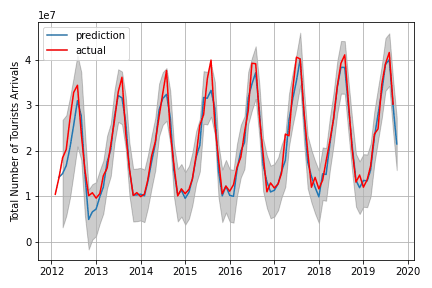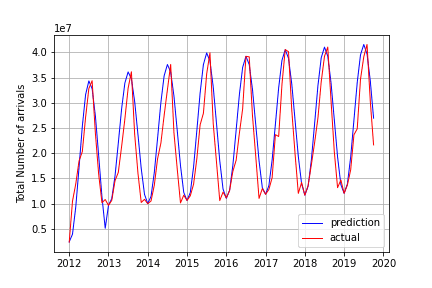by Angelica Lo Duca and Andrea Marchetti (IIT-CNR)
Within the Institute of Informatics and Telematics in Pisa (Italy), a novel working group was born, called Human-Centered Technologies (HCT). One of the main objectives of HCT involves the definition of decision support systems, which help stakeholders and people in general to understand the Italian society, economy and health. Within this context, we have implemented a strategy to assess the impact of the COVID-19 outbreak on the Italian tourism industry in terms of tourism income and reduction in the number of tourist arrivals.
Breaking events, such as terrorism attacks and or political instabilities, tend to influence the trend of the tourism industry, by reducing the tourism demand. The timing of this paper, November 2020, a new pandemic, called COVID-19, is still ongoing, causing more than 1 million cases in Italy. The COVID-19 outbreak was identified for the first time in China on 2019, 31st December, and then spread all over the world [1].
In order to reduce the spread of the virus, many governments launched different restriction laws, including people mobility reduction. This paper quantifies the impact of the Italian COVID-19 outbreak on the tourism industry for the months of February and March 2020. In particular, the impact of the COVID-19 outbreak is calculated in terms of two metrics: the number of tourist arrivals, which is the number of visitors reaching Italy, and the tourism income, which is calculated as the product between the tourist spending and the number of tourist arrivals. The tourist spending is the sum of expenses carried out by visitors to purchase goods and services used for and during the vacation, or in travel and in the tourist stay. Usually, the average tourist spending can be considered constant for the considered period of time. The tourist spending is extracted from “Tavole Dati Turismo”, released by Banca d’Italia [L1], and from “Spese per viaggi in alloggi a pagamento” released by Istat [L2].
This paper analyses the time series regarding the number of tourist arrivals to accommodation establishments in Italy. Data have been extracted from the European Statistics: Annual Data on Tourism Industries [L3]. An analysis of the trend of the time series revealed a breaking point in March 2020, due to the restriction laws imposed by the Italian governments to cope with the COVID-19 pandemic. Therefore, it is possible to break down the time series into three parts: before (January 2012-February 2020), during (March 2020/April 2020-May 2020) and after the first lockdown (starting from May 2020).
Data before the lockdown (historical data) can be represented through a model, which is then used to predict the behavior of the time series if the COVID-19 outbreak had not occurred, during and after the first lockdown (March 2020-May 2020). Historical data are compared with data during and after the first lockdown (actual data), in order to calculate the gap between the predicted number of tourist arrivals (without the effects of the COVID-19 outbreak) and the actual number of tourist arrivals (with the effects of the COVID-19 outbreak). The obtained gap is then used to calculate the reduction in tourism income due to the COVID-19 outbreak.
We propose two strategies to model historical data. The first strategy exploits a statistical model called SARIMA [2], and the second strategy exploits mathematical concepts to build a sinusoidal model [3].
A recovery model from the crisis is also proposed, based on a linear regression model. Three scenarios are defined, considering three possible recovery periods: best-case, with a recovery period of 6 months after the fist lockdown, base-scenario with a recovery period of 24 months, and worst-scenario with a recovery period of 40 months.
Statistical Model
The time series before the lockdown (historical time series) can be modeled through a SARIMA model, in order to predict which would have been the trendline of the number of tourist arrivals, if the COVID-19 outbreak had not occurred (Fig. 1). In order to build the SARIMA models, the Autocorrelation (ACF) and Partial Autocorrelation (PACF) plots can be used, as well as the number of transformations needed to make the time series stationary, through a Dickey-Fuller test.

Figure 1: A comparison between the SARIMA model and actual data.
Mathematical Model
The time series before the lockdown can be modelled also through a sinusoid with a variable amplitude (Fig. 2), where maximum peaks correspond to the high seasons (August) and minimum peaks to the low seasons (December). Two linear regression models are used to calculate lines crossing maximum and minimum peaks, respectively.

Figure 2: A comparison between the sinusoidal model and actual data.
Discussion
The sinusoidal model shows that for the months of February and March 2020, the reduction in terms of tourism income due to the COVID-19 outbreak should be of 1,713,632,577 € for February and 7,168,022,367 € for March.
The statistical model has been used to calculate the reduction in tourism income, considering the three recovery scenarios. In the worst-case scenario (6 months) the reduction in tourism income would be $ 137,727,300,190, in the base case ( 24 months) it would be $ 91,811,091,246, in the best case (40 months) it would be $ 45,078,563,960.
Links:
[L1] https://kwz.me/h2x
[L2] http://dati.istat.it/
[L3] https://ec.europa.eu/eurostat/web/tourism/data/database
References:
[1] A. Spinelli, G. Pellino: “COVID‐19 pandemic: perspectives on an unfolding crisis”, The British journal of surgery, 2020.
[2] A. Lo Duca, A. Marchetti: “Assessing the Impact of COVID-19 in the European Tourism Industry”, Journal of Systems and Information Technology, submitted.
[3] A. Lo Duca, A. Marchetti: “Analysing the COVID-19 Impact on Italian Tourism Industry. Journal of Systems and Information Technology. note: submitted.
Please contact:
Angelica Lo Duca, IIT-CNR, Italy











